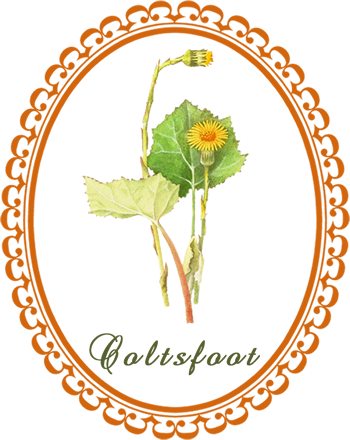
Coltsfoot: one of the best remedies for irritable coughs - effective in the treatment of acute infections like bronchitis and laryngitis, to the management of chronic conditions such as emphysema and silicosis ...
Common Names: Coltsfoot, British Tobacco
Botanical Name: Tussilago farfara
Family: Asteraceae
Plant Type: Herbaceous perennial
Parts Used: Leaves and flowers
Flowering: April
Coltsfoot is a perennial plant native to Europe, North Africa and parts of Asia. It was introduced to Canada in the 1920's, and can now be found in most provinces. It has been positively identified through the Weed Alert Program in 27 counties in Southern Ontario.
Description: Coltsfoot is a low growing perennial plant. It has large, deep green leaves, somewhat similar in size and shape when fully grown to those of velvetleaf or cocklebur. The plant has no main stem, however. The leaf petiole holds the leaves 10 to 20 cm above the soil, often forming a complete canopy covering the soil. The top leaf surface has a smooth, almost waxy appearance, while the underside of the leaf is covered with white wool-like hairs. Usually leaf stems and larger leaf veins are distinctly purple in color.
Coltsfoot spreads by underground rhizomes, which develop mainly 5 to 20 cm deep. These rhizomes produce quite dense stands of above-ground foliage. It is common to find only 2 or 3 patches of coltsfoot in a field, with patches gradually expanding outward due to rhizome growth. These patches usually range from 3 to 6 metres in diameter. Coltsfoot has a very unique flowering characteristic. The bright yellow flowers, similar to dandelions but slightly smaller, appear early in the spring, before any leaves emerge. In Southern Ontario, coltsfoot flowers in April, often before the last of the snowbanks have melted. Flower heads have even been known to push through snow. The white, fluffy seed heads also resemble those of dandelions. However, coltsfoot seed will mature by the time the very first dandelions are coming into bloom. Coltsfoot is not a prolific seed producer compared to many annual weeds, with each plant reported to produce about 3500 seeds.
As seed on earlier flowers ripens, the coltsfoot leaves finally begin to emerge above ground. Leaves will continue to grow in number and size for several weeks, so that the canopy does not reach full density until late June to mid-July. During the summer, food is stored in the rhizomes for the following year's early spring growth.
Cultivation: Coltsfoot can be found growing wild by roadsides, hedgerows, fields and waste ground. Coltsfoot does well in moist, average soil in full sun; it is hardy to zone 4.
Harvesting: The flowers appear on the plant first, followed by the leaves. Harvest the flowers when they appear and mature (March to May), and the leaves can be collected from May to July.
Coltsfoot Magick
Love. Peace. Visions.
Gender: Feminine
Planet: Venus
Element: Water
Add to love sachets and use in spells for peace and tranquility.
Smoke the leaves to aid in obtaining visions.
Herbal Healing with Coltsfoot
Medicinal Actions: Anti-tussive, demulcent, diuretic, expectorant, pectoral, tonic
Medicinal Uses: The name "tussilago" itself means "cough suppressant." Coltsfoot is a soothing expectorant with anti-spasmodic action, which can be used in the treatment of chronic or acute bronchitis, whooping cough, asthma, and chronic emphysema. It is a mild diuretic. Bruise the leaves and use as a poultice on boils, ulcers, and abscesses.
Traditionally, a poultice of crushed leaves or a leaf decoction is used externally. This is applied to sores, injuries, rashes as well as painful joints. The large mucilage content accounts for most of the medicinal benefit derived from the plant.
As mentioned previously, this herb is often used as a cough remedy and has been used for centuries in Chinese medicine, but the internal use of this herb does have a down side.
When taken internally the pyrrolizidine alkaloids found mostly in the flower heads, can cause problems when used at a too high concentrations for an extended period of time. The pyrrolizidine content of the leaves is lower than the flower heads.
Native American Herb Wisdom
The leaves are the main ingredient in the so-called British herb tobacco, smoked to relieve the symptoms of coughs, bronchitis, asthma, etc.
A hot liquid was made using four teaspoons of the dried leaves in a quart of water and left to steep for half an hour. A cloth was saturated in this hot liquid and placed over the chest or throat to ease coughs.
The dried leaves were snuffed up the nostrils for congestion and headache.
Caution: Coltsfoot contains alkaloids that have been shown in animal experiments to be carcinogenic when taken in high doses over a long time. The normal medicinal dosage is much lower, and the whole herb (as opposed to the extract) has not been shown to pose a problem when taken at a normal dosage.
If you appreciate the information provided,
please help keep this website running. Blessings!
© 2008-2022 aromaworx.ca. All rights reserved.

